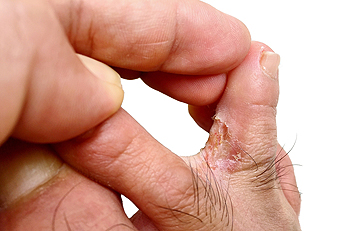Symptoms and Causes of Athlete’s Foot

Athlete’s foot is a common fungal infection that, while highly contagious, is generally not detrimental. Anyone who comes into direct contact with the tinea fungus can get athlete’s foot. This fungus thrives in a warm, moist atmosphere frequently found in gym locker rooms, public showers, and swimming pools. For that reason, wearing appropriate shower shoes or flip-flops in such areas is recommended. Because the fungus also can be transmitted simply by using a towel of someone who is infected, sharing towels should be avoided. An athlete’s foot infection causes itchy blisters to form between the toes or on the bottom of the feet. Sometimes, they may ooze or crack the skin, leaving the area more vulnerable. A number of antifungal creams, lotions, sprays, or powders are available to fight off the fungal infection. However, it is suggested that you seek the help of a chiropodist if your foot is red, hot, and painful, which may be signs of a more serious infection. If you have diabetes or a weakened immune system, a visit to the chiropodist is also strongly suggested.
Athlete’s foot can be uncomfortable and unsightly. To learn more about preventing and treating this condition, please consult with one of the chiropodists from The Footcare Centre. Our chiropodists will assess your condition and provide you with quality foot and ankle treatment.
What Is Athlete’s Foot?
Athlete’s foot refers to an infection of the skin on the feet that is caused by a fungus. This fungus is contagious and thrives in warm and moist environments. It is often spread in common areas such as public pools, locker rooms, and showers. It can also spread when sharing personal items, like shoes or towels, with an infected person.
Symptoms
The symptoms of athlete’s foot may include:
Itching, stinging, or burning of the skin on the feet
Cracking or peeling skin, especially between the toes and on the soles of the feet
Scaly, red rash on the foot
Blisters
Foul odor
Treatment
Treatment for athlete’s foot typically involves using over-the-counter topical antifungal medications on the feet. When over-the-counter options are ineffective, you may need to take prescription oral medications or topical antifungal drugs, or a combination of both.
Prevention
Preventing athlete’s foot places an emphasis on good foot hygiene practices.
You can prevent athlete’s foot by:
Washing and drying your feet thoroughly every day
Wearing shoes when walking in public areas
Not sharing personal items, like shoes or socks, with others
Wearing shoes and socks made out of breathable materials
If you have any questions, please feel free to contact our office located in . We offer the newest diagnostic and treatment technologies for all your foot care needs.
